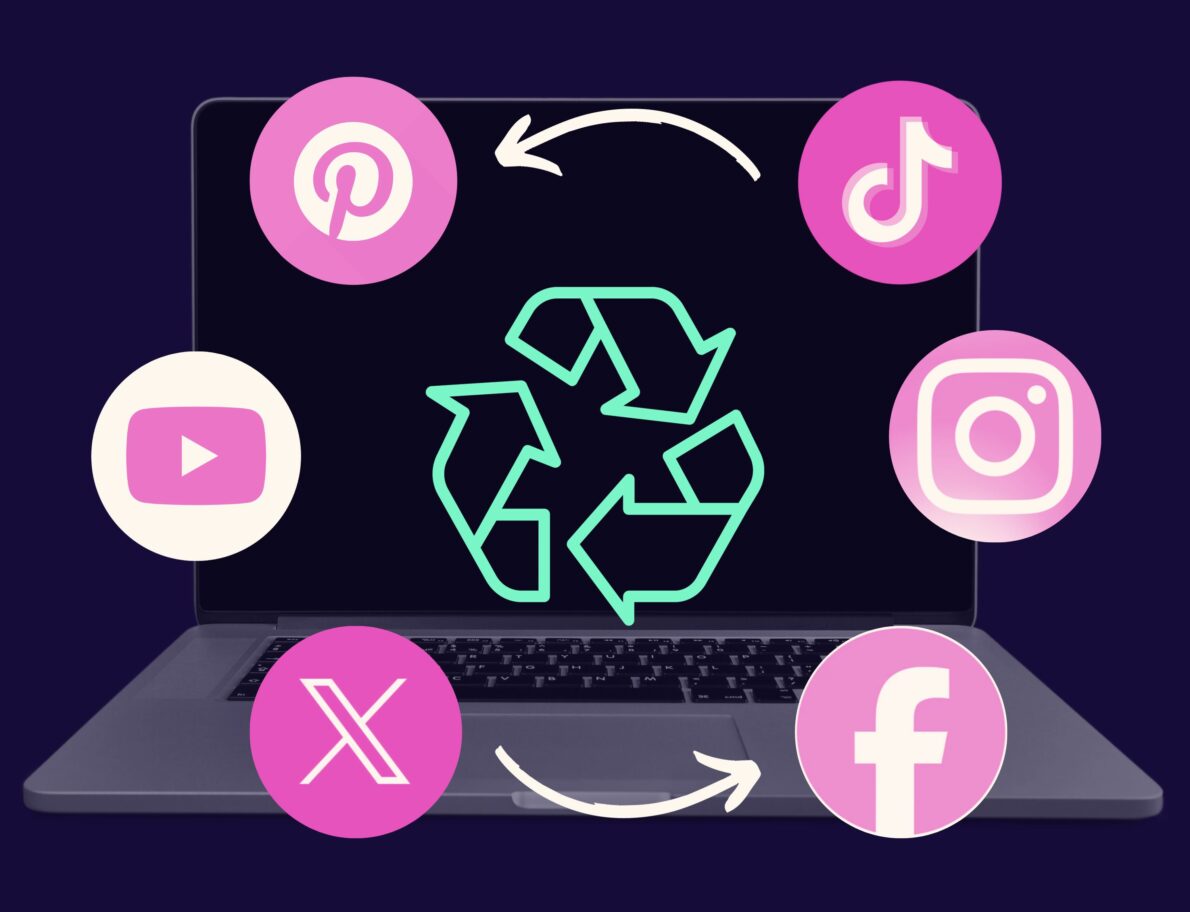Content brainstorming used to be the most fun part of your day. But when you need to come up with daily topics and fresh takes for multiple marketing channels?
Well, let’s just say that creative flow can quickly hit a wall.
Don’t get us wrong; your blog and social platforms benefit most from unique ideas that set your brand apart from the competition. But if you repurpose content to new formats and platforms? You dodge writer’s block, build authority, and expand your reach.
Repurposing content is the process of reusing and reformatting your existing content into new pieces of content for unique marketing channels, such as turning a long-form blog post into a social media caption, podcast script, and infographic.
We sat down with Lyon Content’s SEO expert Kim Fischer to walk us through content repurposing for blogs, social media, and even podcasts, all while keeping your Google rankings sky-high.
Ready to make the most of your content? Join us on the prowl.

What is content repurposing?
Content repurposing is the digital marketing tactic of reusing existing content and restructuring it into different formats for various marketing platforms, such as turning a video into social media posts, infographics, and blog posts.
One important distinction? Repurposing doesn’t mean duplicating.
That misconception could tank your brand authority and Google rankings.
Repurposing is more about restructuring and presenting the same ideas in a different way. For example, you could recycle a blog’s key points into an Instagram carousel that captures your audience’s attention in a more visual way.
Why is Content Repurposing Important?
Content repurposing is important for three reasons: scaling content, making SEO gains, and inspiring more audience engagement.
Let’s face it: even with impeccable keyword research, you might run out of topic ideas for one platform or another. When you repurpose content, you scale your content calendar to new heights, reach new audiences, and raise SEO rankings.
The best part? Kim says repurposed content boosts conversions, especially on platforms like Pinterest, Instagram, and TikTok:
“Experts used to say that we need to see something seven times before we take action—now it’s even more because of how quickly we consume content.”
Think about how quickly you scroll past a news update on Facebook or skim a blog article. It’s easy to miss the meat of the message, which is why Kim says audiences need to see it again:
“Remember that your audience isn’t reading every single piece of content you put out, they forget, and they need to be reminded.”
In marketing, it’s not just okay to repeat yourself—it’s strategic! And some ideas will naturally lapse into different platforms. Kim offers these quick SEO tips to keep repurposed content pumping up your rankings:
- Link back to blog posts you repurpose content for on other channels
- Keep answering unique questions (these are often long-tail keywords) for your audience
- Clearly distinguish your content from your rivals
“SEO doesn’t act in a silo,” says Kim. “All marketing channels can help lift each other up.”
With that in mind, let’s get to your go-to content repurposing workflow.

How to Repurpose Content: 4 Key Steps
Later in this guide, we’ll dive into tangible repurposing ideas for different types of marketing channels. But first, let’s break down some essential steps and tips for repurposing content, no matter which platform you’re dealing with.
1. Start with long-form content
It’s usually easier to repurpose content from a blog or whitepaper into a tweet than vice versa. Why? Kim reminds us that longer pieces of content give you a trove of material to work with:
“My best piece of advice to business owners and marketers is to start with the long-form content (whichever is easiest for them to create),” says Kim. “Then adapt it to the other types of long-form content, and then break it down into the various types of short-form content.”
Prime example? Here’s how we repurpose content from a blog article into an Instagram post:
First, we wrote a 2,000+ word article about the industry’s best content writing agencies.

As you scroll through the article, you’ll see the content is structured with detailed text, bullet points, headings, and the occasional image to break things up.

This extensive article gives us a wealth of information. So we took the highlights and trimmed them into smaller snippets for our Instagram audience.
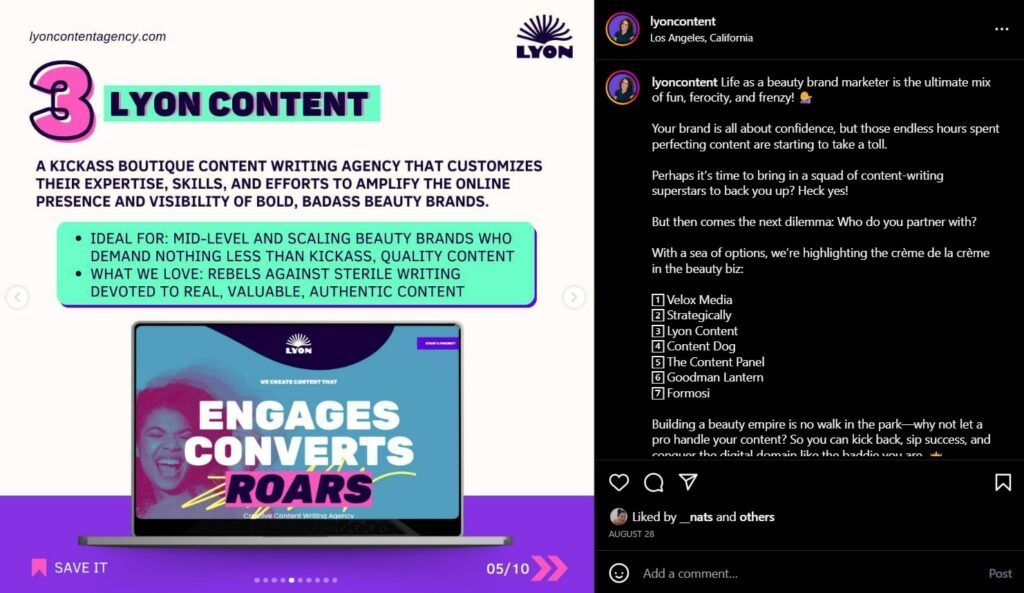
Remember, it’s not just about going from long-form to short-form. Kim recommends initially repurposing long-form content into other long-form mediums like ebooks, case studies, or whitepapers (before going to short-form like Tweets and captions).
Either way? Your audience on each platform is your #1 priority.
2. Adapt content to the platform and audience
Let’s say you published a heavy-hitting blog article that reigned supreme on the SERPs, garnering you tons of traffic. So, naturally, you decide to repurpose content from that killer article for a social media post.

You craft a punchy caption from your meta description, link to the article, pair it with a stock photo, and voila!—a new Instagram post. But merely directing social media followers to your blog isn’t what repurposed content is all about.
According to Kim:
“You have to take into account what makes something successful on each platform.”
Think about the unique features your blog offers—branded design, expansive text space, headings, and images. But Instagram? The platform offers dynamic options to repurpose content from long blocks of text like:
- Carousels
- Video content
- Photos
- Engagement
- Filters
- Infographics
Plus, your target audience digests social media content differently from blog content (more on that later). The gist? They want to consume bite-sized bits of knowledge, not links to lengthy blog posts. Kim says the same goes for TikTok versus YouTube videos:
“You wouldn’t take a YT (YouTube) video and post it on TikTok— most people on TikTok aren’t prepared to have the attention span to sit and watch a 10-minute video.”
But it’s not just about attention span.
Some content just doesn’t work on certain platforms. Your fun, dancing TikTik video that boosts brand awareness might not resonate with your more professional LinkedIn crowd.
“It’s all about knowing your audience on different platforms,” emphasizes Kim.
Now, let’s see this concept in action.
How to Repurpose content example: Canva’s web audience vs Instagram audience
Ever browsed through Canva’s many templates? You’ve got hundreds of thousands to pick from.
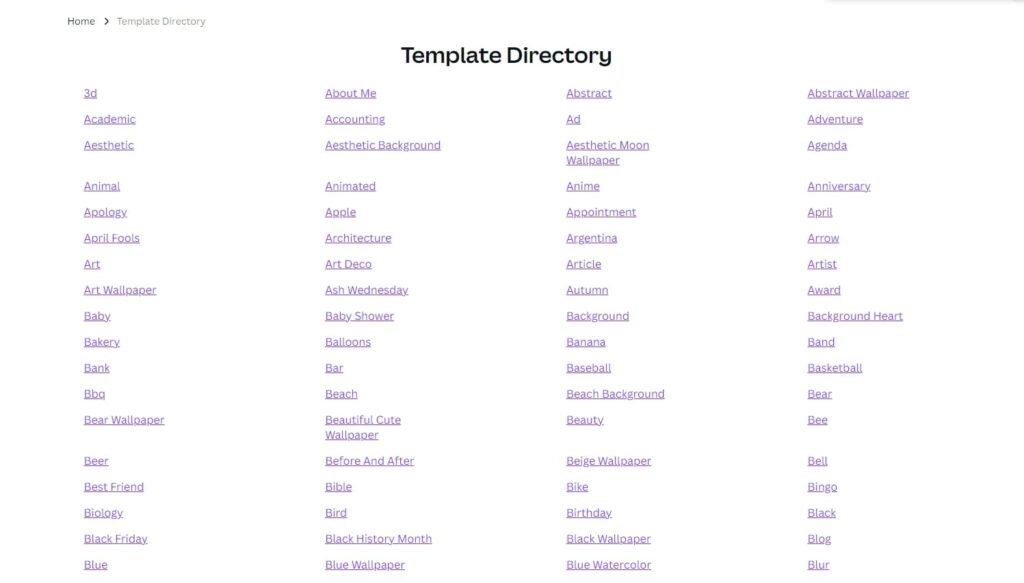
Maybe you want to get more organized, so you browse the “Schedule” templates.
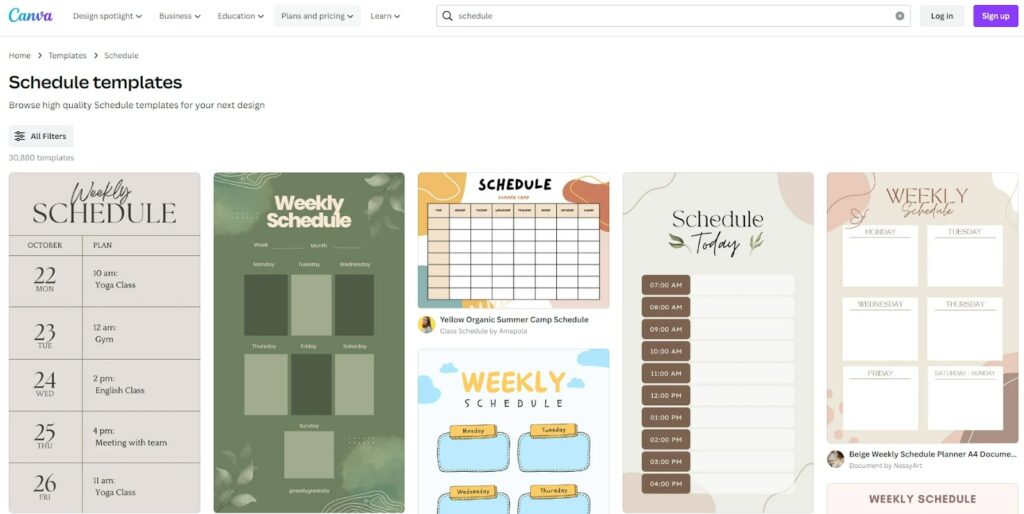
Yeeesh—30,000 options and counting.😯 Still, you take a scroll.
But Canva knows you’re not the same person casually scrolling through their Instagram. That’s why they repurpose content from those schedule templates on their site into a short, punchy Instagram Reel.
They showcase a range of different schedule template categories like monthly calendars, class timetables, and to-do lists—all in a format that’s a little easier on the eyes.
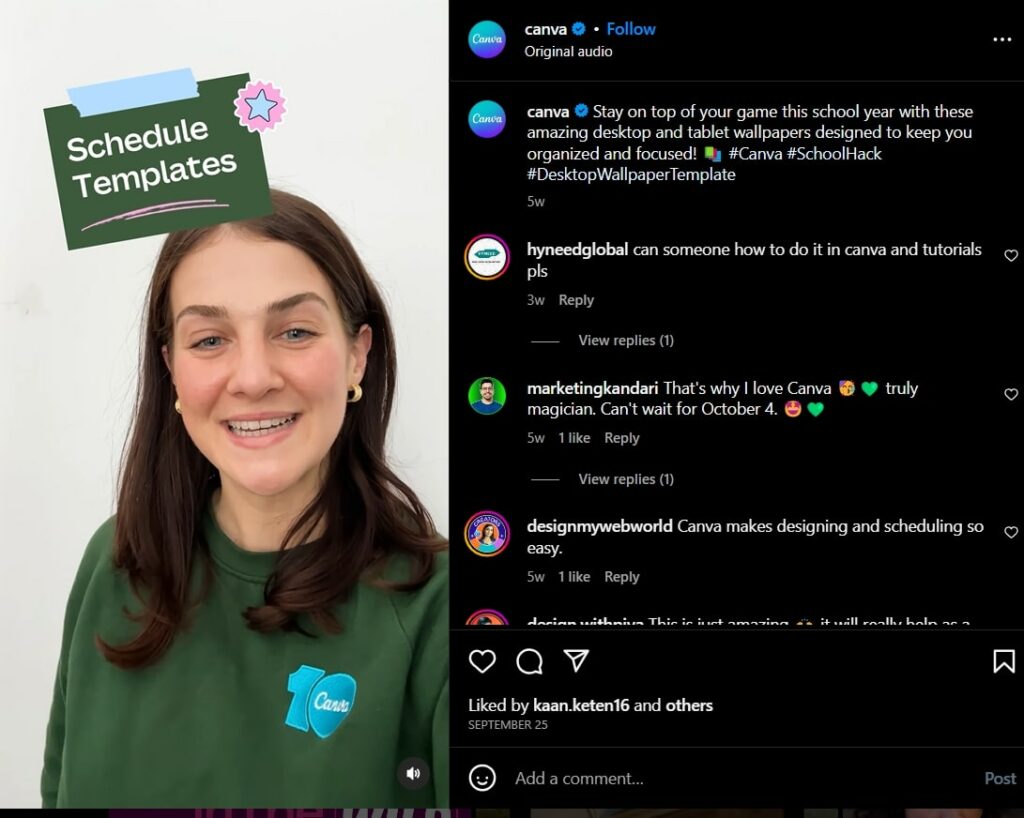
The Reel gives their time-pressed audience a quick overview of their otherwise lengthy list of templates.
It’s the same product, tailored to a new audience and platform.
3. Keep content evergreen by revamping and re-optimizing
Evergreen content indicates long-term relevance, meaning the content stays relevant and accurate for a longer period of time.
For example, if you have a blog article about 2023 beauty trends, chances are it won’t be evergreen into 2024. Therefore, you’d update it to include forecasted 2024 trends. Your update would also include new statistics, fresh takes, and more recent examples to reflect the times.
Of course, you could repurpose content for each piece, but Kim says it’s much easier to work with content that doesn’t need as many frequent revamps or updates:
“Evergreen content tends to be the most valuable to repurpose because we can repurpose content again and again and again.”
Take our informational article about what content writers do. We’ll still update this article quarterly to reflect any changing industry norms, but overall, content writer duties won’t change dramatically, meaning the article is relatively evergreen.

4. Test different types of content
Let’s say you’re a brand-new lip gloss company. Your biggest inspo? Dior and their iconic lip maximizer. But here’s the thing: you’re a startup, and they’re an industry titan. That means your audiences are worlds apart.
So if Dior is repurposing an advertisement into a Tweet and it’s a hit, that doesn’t mean your audience will eat up the same strategy.
That’s why Kim swears by testing and performance monitoring for any content repurposing:
“Start by repurposing it all. From a blog, you can easily get 20+ pieces of content for all of your other platforms,” says Kim. “See what translates and does well, and do it consistently. You have to do the work consistently to be able to see that data, see the traffic, and see patterns.”
Just don’t get too caught up with vanity metrics like views and likes on Instagram—they don’t paint the full picture of your repurposed content’s success. Kim’s top metrics?
- Website clicks: These show you how many people navigate to your website after seeing your repurposed social media content.
- Conversions: Signups, downloads, and (most importantly) purchases that result from your repurposed content mean it’s working!
- Shares: If your social content is slammin’, you should make it to your audience’s DMs, feed, and “Saved” folders.
These metrics will show you what’s actually resonating with your audience, rather than just gaining short-term traction that dwindles out.
Ready to repurpose content and experience the magic?
Kim shares some of the best-performing content repurposing strategies she’s seen across Lyon Content’s roster of clients in the beauty, marketing, tech, wellness, and lifestyle niches.

Ideas for Repurposing Blog Content into Other Content Formats
Remember that carousel post we fashioned from our content writing blog post earlier? That’s just the tip of the iceberg when it comes to repurposing blog content.
Here are some more ideas to turn your existing blog articles into social media posts that generate serious buzz:
- Statistic- and research-heavy blog posts into eye-catching infographics
- Industry trend articles into engaging Twitter threads
- Roundups or tips into swipe-worthy carousels
- Blog quotes into thought leadership Instagram highlights
- How-to blog posts into YouTube tutorials or guides
- Comparison articles into fun, interactive quizzes
- Case studies into entertaining videos, press releases, or Reel interviews
- Blog post clusters into insightful webinars or ebooks
- Informative blog posts into a value-packed course
But hey, you might not have a social media manager with enough time to sift through your entire blog history.
That’s where seasoned content writers like us step in, we can repurpose content and in turn, lighten your load while keeping your content calendar fresh, engaging, and climbing the SERP ranks!
All done repurposing your blog? Let’s move on to that podcast!
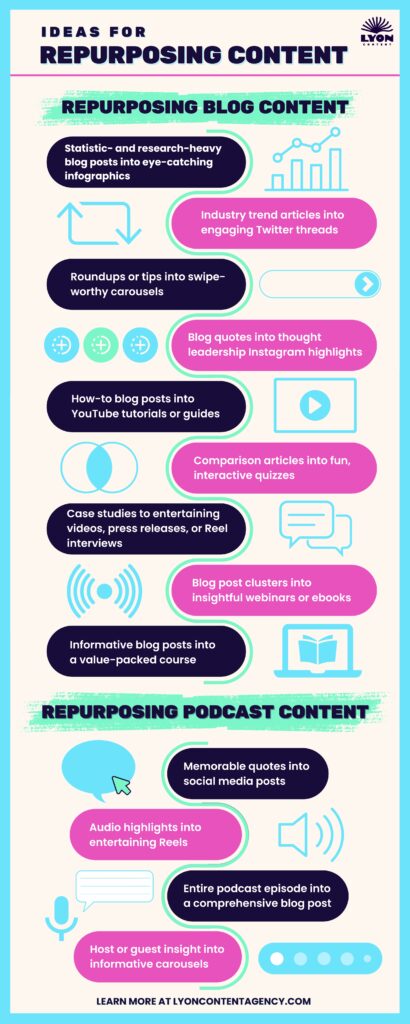
Ideas for Repurposing Podcast Content
Podcasts breathe life into your content, infusing it with vibrant voices, emotions, and conversations. That’s why they connect so well with audiences. This was evident as ever during COVID-19, when people listened to podcasts more than ever, as brands quickly started to include podcasts in their digital marketing strategies.
And guess what? They’re rich with repurposing potential.
Transform in-depth white papers and articles into podcast episodes for audiences that prefer listening over reading.
Repurpose:
- Memorable quotes into social media posts
- Audio highlights into entertaining Reels
- Entire podcast episode to a comprehensive blog post
- Host or guest insight into informative carousels
Kim’s top repurposed content for podcasts? Blog posts!
“If you can do SEO keyword research before recording the podcast, you’ll have the best opportunity of creating a blog post that can rank.”
Want to keep your recycled podcast SEO-friendly when you post it as a blog?
Easy! Just include:
- Heading tags to create structure
- Images with descriptive alt tags (HTML that outline the words that appear when you hover over the image.
- Backlinks to the original podcast episodes
- Internal and external links to relevant posts
- Indexing through Google Search Console (request indexing for your page through the platform’s URL inspection tool to ensure you show up on the SERPs).
And if all this sounds way too overwhelming in your already-packed marketing agenda? We have the fix.😉
Unleash the Power of Content Repurposing with Lyon Content!
When you repurpose content, you open more doors to connect with your audience, build brand awareness, and soar those SERP rankings.
That said, it’s not always easy to find your content repurposing workflow.
You still need to keep tabs on SEO items (like optimized headings and keyword research) while adapting to different social media platforms and audiences. Plus, your content calendar might already have you struggling to come up for air.
If only you had a team in your corner that could tackle the task head-on.
Lyon Content brings years of experience in content creation to the table—from creating content strategies to writing engaging blog posts to crafting striking social media posts. Our client roster? Diverse as heck. Our writers? Skilled, adaptable, and ready to make your words work.
Repurposing content is just another powerful tool in our ass-kicking marketing arsenal— let us harness it for your brand. We’ll give your content the fire it needs to captivate and convert.

11/15/2023
Chrissy is a contributing writer at Lyon Content based in Toronto. She loves writing and editing tech, marketing, and lifestyle content. But her favorite part of writing is helping businesses express themselves. When she isn't writing, she's traveling as much as possible and eating a lot of cheese.

